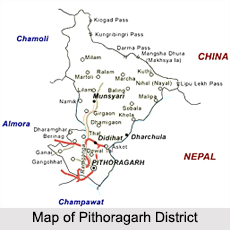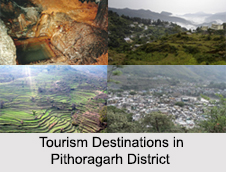 Pithoragarh District is one of the administrative districts of Uttarakhand. Pithoragarh town is the district headquarters. This district has internal borders in its northern and eastern sides. This district is beautified with snow capped peaks of Himalaya Mountains. Being the last district adjoining Tibet, Pithoragarh district has tremendous strategic importance.
Pithoragarh District is one of the administrative districts of Uttarakhand. Pithoragarh town is the district headquarters. This district has internal borders in its northern and eastern sides. This district is beautified with snow capped peaks of Himalaya Mountains. Being the last district adjoining Tibet, Pithoragarh district has tremendous strategic importance.
History of Pithoragarh District
It was in the wake of the Chinese aggression that on 24th of February, 1960, a sizeable section of Almora district was carved into Pithoragarh district with its headquarters at Pithoragarh town. On 15th of September, 1997, Champawat Tehsil, came under Pithoragarh and was carved into Champawat district. The origins of the name Pithoragarh are foggy and there are a number of stories on the same. While some say the name to the King Pithora Chand from the Chand Dynasty, stories on the city getting its name from Prithvi Raj Chauhan by the Chauhan Rajputs are also the part of folklore.
Geography of Pithoragarh District
Pithoragarh is located at a height of 1645 metres above sea level. Pithoragarh District lies between 29 degree 4 minutes to 30 degree 3 minutes` north latitude and 80 degree to 81 degree east longitude. Pithoragarh District is located along the eastern and southern part of the central Himalayas with Indo-Tibetan watershed divide in the north and Kali River forming a continuous border with Nepal in the east. Pithoragarh District is surrounded by boundaries of Almora District, Champawat District, Bageshwar District and Chamoli District and extends over an area of around 7,217 sq kms.
Pithoragarh District abounds in rivers some of which after assuming a peripheral course along the borderline enter the Garhwal region and eventually merges into Ganga River and have thus been geographically grouped under the rivers of the Ganga system. Girthi, Keogad, Kali River, River Garbyang, Dhauli River and Sarju River are some of the main rivers flowing through the district. The northern hilly zone is covered with dense forests, particularly on northern slopes, with an elevation of about 14,000 feet.
Demography of Pithoragarh District
According to the 2011 census, total population of Pithoragarh District is 4, 62, 289 out of which male population is 2, 27,615 and female population is 2,34,674. Total literacy rate of the district at present is 75.95 percent. The native tribes of this district are Van Rawats and Bhitiya. These are nomadic tribes.
Administration of Pithoragarh District
Pithoragarh District has been divided into six tehsils namely Munsyari, Dharchula, Didihat, Gangolihat, Berinag and Pithoragarh. It has two sub-tehsils Dewalthal, Kanalichhina having its headquarters at Pithoragarh and the Commissioner headquarters is at Nainital. Administration of Pithoragarh District consists of eight Development Blocks, three towns, 64 Nyay Panchayats and 644 Gram Panchayats. There are 1672 villages in the district out of which 1579 are inhabited.
Tourism in Pithoragarh District
The breath taking beauty of the Himalayas, wide expenses of grassy meadow, perennial streams roaring down the criss-cross course, a stupendous variety of flora and fauna, and the charm of the serene nature are some of the main attractions of Pithoragarh District. Moreover, there are several popular tourist spots in Pithoragarh District. Some of the prominent ones are Chandak, Thal Kedar, Gangolihat (77 kms) famous for its kali temple, Patal Bhuvneshwari Temple (99 kms), Berinag (Tea Garden of Chaukori - 11 km away from Berinag), Didihat, Munsyari (base camp for treks to Milam, Ralam and Namik Glacier), Dharchula Dehat (base camp for Kailash Mansarovar Yatra, Adi Kailash Yatra, Narayan Swami Ashram) and Jauljibi.
Pithoragarh District, commencing its boundaries just at the foot of the Himalayas, has acquired the unique distinction of being the holy land of Gods.






